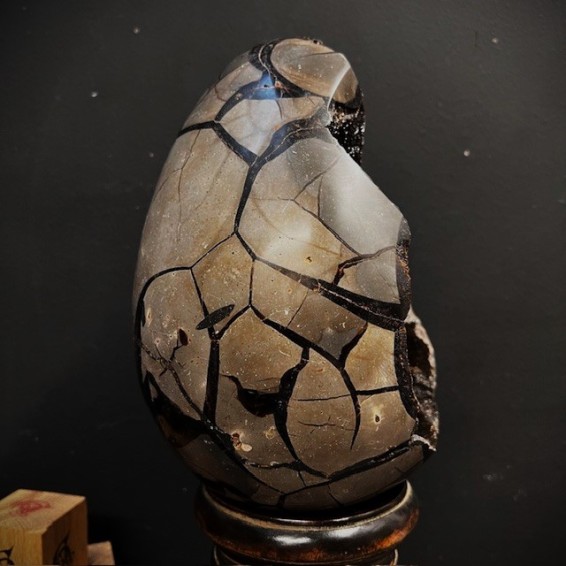
Display for ball or ostrich egg (Large)
High base specially designed to hold a ball or egg
Perfect for ostrich eggs
Not suitable for emu, rhea or swan eggs, for example









Dragon Stone
Septaria egg of Madagascar
It's huge!
Septaria Madagascar egg
Also known as Dragon Stone
Septaria is a stone composed of a mixture of yellow calcite and sandstone, found mainly on the island of Madagascar, characterized by highly visible shrinkage cracks. These highly visible cracks, known as Septa, fill with minerals over time.
When the stone is polished, these cracks stand out, giving it a dragon's egg appearance on the outside.
With time, tectonic movements, etc., the nodules can be fractured and new mineral solutions can invade the shrinkage cracks, often calcite.
In our case, Septaria has been polished into an egg shape and the interior has been invaded by a very fine crystallization of calcite. Beautiful crystals.
It's also easy to see why it's called Dragon's Stone: the exterior is very similar to a dragon's egg!
Sold without base
Ref OSM46: Weight: 7.1kg - Height: 23cm average It's huge!
Sold without the base
You can find available bases by typing ball base or egg base in the site search.
High base specially designed to hold a ball or egg
Perfect for ostrich eggs
Not suitable for emu, rhea or swan eggs, for example
display for ball or egg (small)
Material: Resin material
Wooden base for ball or sphere - Base - support
Grey-Black patinated marble base for ball or sphere
Base - support
Leaves butterflies under oval glass bell - Kallima Inachus
Antique pharmacy display jar
Blown red glass
Bat with wings spread under globe
Species: Cynopterus brachyotis
Bell height 41 cm
No shipping
Naturalist Magnifier
Morpho Didius butterfly from Peru
Entomological box
Butterflies: Asian Papilio
Papilio ulysses - Papilio blumei - Papilio maackii
De l'Homme et de la Femme (Of Man and Woman)
By M. de Lignac - Volume 3
Anatomy of procreation - 1779
Diaphanization of a mouse - Mus musculus
Biological preparation
The aim of diaphanization is to render the tissues transparent through a chemical process, and specific dyes are used to highlight the skeleton.
You can see the bones through the skin!
Large Model
All specimens are different
Deer antler sculpture - Skeleton on pedestal
Material : Antler
Origin: Indonesia
Red chalk drawing- Anatomical drawing
Anatomical study
Drawn by Eugène de Montchoisy in Saint-Brieuc in November 1840
These are not reproductions but original period drawings in red chalk.
You are purchasing one plate, not the entire set of plates
Deer antler wood sculpture - Octopus on pedestal
Material : Antler
Origin: Indonesia
Antique surgical board
From Benjamin Bell's Complete Course in Surgery, published in 1796
Cours d'opérations de chirurgie, démontrées au Jardin Royal
Course of surgical operations, demonstrated in the Royal Garden
Published in 1751 in Paris, by d'Houry, sole printer and bookseller to Monseigneur le Duc d'Orléans
Fourth edition
Illustrated with numerous plates and engravings in the text, including the famous plate of Poor Malabou and her scrotal elephantiasis on page 112/113, which the author mentions on page 373.
Carved swordfish rostrum: Unique piece
Skulls motifs
Indonesian craftsmanship
Celestine Egg - Mineral WITH base
Origin: Madagascar
Be careful to protect it from water, which alters it: it dissolves or cracks on contact!
Sold with base
Antique bezoar - Antipoison - Antidote
Once sold by the apothecary, bezoar, also known as gallstone, was reputed to have the same anti-poison properties as the legendary unicorn's horn, hence its excessively high price, also due to its great rarity.
An important piece in a cabinet of curiosities
Sold alone - Without stand, sold separately

Dragon Stone
Septaria egg of Madagascar
It's huge!








